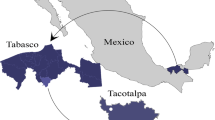Summary
Gender identification of forensic samples was determined by amplifying a segment of the X-Y homologous gene amelogenin. Using a single pair of primers spanning part of the first intron, 106 by and 112 by PCR products were generated from the X and Y homologues respectively, which were then resolved by agarose gel electrophoresis. This test enabled as little as 20 pg of DNA from severely degraded bones to be amplified and typed in a single tube reaction. Furthermore, using dye-labelled primers, it was possible to quantitate, by automated fluorescence detection, the relative yields of X and Y -specific PCR products generated from mixtures of male and female DNA. The versatility of this sex test was further demonstrated by co-amplifying with the HLA-DQA1 Amplitype kit in a combined gender/identity DNA test.
Zusammenfassung
Durch Amplifikation eines Segments des X-Y-homologen Gens Amelogenin wurde eine Geschlechtsidentifikation forensischer Proben durchgeführt. Mit einem einzigen Primerpaar, welches einen Teil des ersten Introns überspannt, wurden PCR-Produkte mit 106bp und 112bp von den homologen Anteilen des X- und des Y-Chromosoms generiert, welche dann mit Hilfe der Agarosegelelektrophorese aufgetrennt wurden. Dieser Test erlaubte es, daß so geringe Mengen wie 20pg DNA von stärkergradig degradierten Knochen amplifiziert und ineiner Einzelreaktion typisiert wurden. Durch Benutzung von farbstoffmarkierten Primern war es ferner möglich, durch automatisierte Fluoreszenzdetektion die relative Ausbeute von X- und Yspezifischen PCR-Produkten zu quantifizieren, wie sie von Mischungen männlicher und weiblicher DNA generiert wurden. Die Vielseitigkeit dieses Sex-Tests wurde ferner dadurch nachgewiesen, daß eine Co-Amplifikation mit dem HLA-DQA1 „Amplitype”-Kit in einem kombinierten Geschlechtsbestimmungs-und Identifizierungs-DNA-Test möglich war.
Similar content being viewed by others
References
Verbovaya LV, Ivanov PL (1991) ‘Sexing’ deoxyribonucleic acid (DNA) on DNA fingerprint gel: an internal control for DNA fingerprint evidence. J Forensic Sci 36: 991–998
Gill P (1987) A new method for sex determination of the donor of forensic samples using a recombinant DNA probe. Electrophoresis 8: 35–38
Kogan SG, Doherty M, Gitschier J (1987) An improved method for prenatal diagnosis of genetic diseases by analysis of amplified DNA sequences. Applications to haemophilia A. N Engl J Med 317: 985–990
Ebensperger C, Studer R, Epplen JT (1989) Specific amplification of the ZFY gene to screen sex in man. Hum Genet 82: 289–290
Witt M, Erickson RP (1989) A rapid method for the detection of Y-chromosomal DNA from dried blood specimens by the polymerase chain reaction. Hum Genet 82: 271–274
Pascal O, Aubert D, Gilbert E, Moisan JP (1993) Sexing of forensic samples using PCR. Int J Leg Med 104: 205–207
Pfitzinger H, Ludes B, Mangin P (1993) Sex determination of forensic samples: co-amplification and simultaneous detection of a Y-specific and an X-specific DNA sequence. Int J Leg Med 105: 213–216
Fattorini P, Caccio' S, Gustincih S, Florian F, Altamura BM, Graziosi G (1993) Sex identification by polymerase chain reaction of alpha-satellite in aged tissue samples. Electrophoresis 14: 23–26
Gaensslen RE, Berka KM, Grosso DA, Ruano G, Pagliaro EM, Messina D, Lee HC (1992) A polymerase chain reaction (PCR) method for sex and species determination with novel controls for deoxyribonucleic acid (DNA) template length. J Forensic Sci 37: 6–20
Handyside AH, Pattinson JK, Penketh RJA, Delhanty JDA, Winston RML, Tuddenham EGD (1989) Biopsy of human preimplantation embryos and sexing by DNA amplification. Lancet i: 347–349
Nakahori Y, Takenaka O, Nakagome Y (1991) A human X-Y homologous region encodes “amelogenin”. Genomics 9: 264–269
Bailey DMD, Affara NA, Ferguson-Smith MA (1992) The XY homologous gene amelogenin maps to the short arms of both the X and Y chromosomes and is highly conserved in primates. Genomics 14: 203–205
Nakahori Y, Hamano K, Iwaya M, Nakagome Y (1991) Sex identification by polymerase chain reaction using X-Y homologous primers. Am J Med Genet 39: 472–473
Akane A, Shiono H, Matsubara K, Nakahori Y, Seki S, Nagafuchi S, Yamada M, Nagome Y (1991) Sex identification of forensic specimens by polymerase chain reaction (PCR): two alternative methods. Forensic Sci Int 49: 81–88
Sullivan KM, Mannucci A, Kimpton C, Gill P (1993) A rapid and quantitative DNA Sex Test: fluorescence-based PCR analysis of X-Y homologous gene amelogenin. Biotechniques (in press)
Akane A, Seki S, Shioni H, Nakamura H, Hasegawa M, Kagawa M, Matsubara K, Nakahori Y, Nagafuchi S, Nakagome Y (1992) Sex determination of forensic samples by dual PCR amplification of an X-Y homologous gene. Forensic Sci Int 52: 143–148
Gill P, Jeffreys AJ, Werrett DJ (1985) Forensic application of DNA ‘fingerprints’. Nature 318: 577–579
Sullivan KM, Hopgood R, Gill P (1992) Identification of human remains by amplification and automated sequencing of mitochondrial DNA. Int J Leg Med 105: 83–86
Waye JS, Presley LA, Budowle B, Shutler GG, Fourney RM (1989) A simple and sensitive method for quantifying human genomic DNA in forensic specimen extracts. Biotechniques 7: 852–855
Rychlik W, Rhoads R (1989) A computer program for choosing optimal oligonucleotides for filter hybridisation, sequencing and in vitro amplification of DNA. Nucleic Acids Res 17: 8543–8551
Bär W, Brinkmann B, Lincoln P, Mayr WR, Rossi U (1992) DNA recommendations-1992 report concerning recommendations of the DNA Commission of the International Society for Forensic Haemogenetics relating to the use of PCR-based polymorphisms. Int J Leg Med 105: 63–64
Walsh PS, Erlich HA, Higuchi R (1992) Preferential PCR amplification of alleles: mechanisms and solutions. PCR Methods Appl 1: 241–250
Author information
Authors and Affiliations
Rights and permissions
About this article
Cite this article
Mannucci, A., Sullivan, K.M., Ivanov, P.L. et al. Forensic application of a rapid and quantitative DNA sex test by amplification of the X-Y homologous gene amelogenin. Int J Leg Med 106, 190–193 (1994). https://doi.org/10.1007/BF01371335
Received:
Revised:
Issue Date:
DOI: https://doi.org/10.1007/BF01371335




